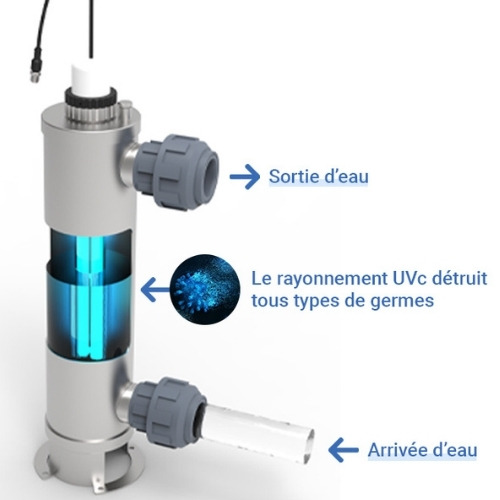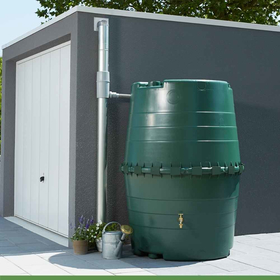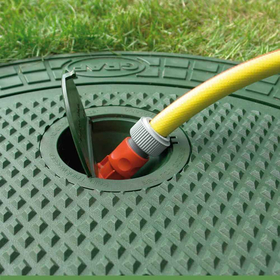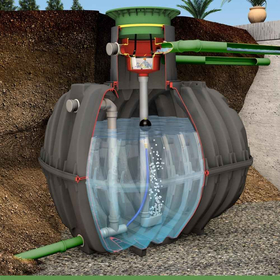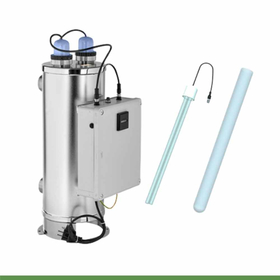Filling your swimming pool with rainwater: our advice
After a summer of 2022 marked by restrictions, filling was at the heart of the news. In addition, the price of energy increasing, that of water should also undergo increases in the coming months. The treatment and distribution of this resource requiring a lot of electricity, the price per cubic meter will inevitably evolve.
If you own a swimming pool, your water consumption is important, especially with the high temperatures that cause high evaporation. So let's explore together whether using rainwater for your pond is a good idea.

How to collect rainwater to fill your swimming pool?
It's very simple: the goal is to store the water that falls on your roof to then reuse it later. During rainfall, a collector positioned in your gutter directly collects the water when it goes down. All ending in a recuperator or a tank.
Sizing your tank is done according to:
- Surface of your roof
- Type of roof
- Average rainfall in your municipality
- Planned consumption
- Number of days of water reserve desired (how many days do I hope to "hold" thanks to my tank)
Discover our article and the online simulator to calculate the volume for your rainwater recovery tank
In order to inject quality water into your pool, you must:
- Filter the recovered water. There are 3 levels of filtration : from the collection on the roof, in the collector (with an integrated filter) then in the tank.
- Treat this water to kill bacteria that can pollute it. Different solutions exist, in particular the treatment of water with a UV sterilizer or chlorine.
Once your installation has been completed, when you top up using rainwater, it is advisable to start filtration. Products against algae may thus be necessary, but this is not necessary if the upstream treatment is of good quality.
The different types of rainwater harvesters
Aerial recuperator
These tanks, positioned outside or in a garage, can store several dozen to several hundred liters of water. The installation is simple, all with an accessible budget (from 200 € for the recuperator, its collector and basic filtration).
How to install a rainwater collector?
Underground tank
To store several cubic meters of water, an underground tank, coupled with a filtration and treatment system, allows greater and more regular use of rainwater.
Collecting rainwater: the benefits for your swimming pool
Rain is a free source of water for your pool. By recovering it, you gain autonomy while requiring less of the drinking water network. The recovered water is easily usable for your garden, to clean the floors or your car. This saves you money on your water bill. Another advantage: you do not require water from groundwater, which is used for our tap water. This is an important element given the multiplication of the number of swimming poolsthese last years. You participate in a reduction of a form of waste of water intended for another consumption.
In addition, a rainwater recovery system enhances your home : restrictions being more and more frequent, a storage tank makes it easier to meet your own needs.
Given the total volume of a swimming pool, your rainwater recovery system is a smart addition for:
- Top up to compensate for evaporation during the hottest days.
- Conversely, at the end of winter , you can use this water to reach the correct water level and also clean the winter cover, the area around the basin, etc.
- Complete after the passage of children or grandchildren who have emptied the pool by jumping all afternoon
Nevertheless, the rainwater that you collect needs to be treated, we will talk about this point later.
The disadvantages of rainwater for your swimming pool
Before advising you on the subject, let us distinguish between two possibilities:
- Your pool fills up during heavy rain
- Regular filling thanks to rainwater stored in a tank
In the first case, the situation is suffered, with consequences that can affect the quality of your pool. Conversely, in the second case, a good installation to recover rainwater makes it possible to control the contributions.
Rainwater runoff into your pool during a downpour
During a heavy downpour, the rainwater carries with it elements and debris that affect the chemical balance of your pool. This is not due to the volume of water, but rather to the quality of the latter. During this precipitation, the water and the wind will deposit dust, leaves and various debris.
The freshly arrived organic matter will then decompose, which will promote the development of organisms and algae. In summer, high temperatures combined with external room inputs can cause the water to turn, rendering it unusable. It's not always pleasant to come back from the weekend and find a green swimming pool...
This sudden arrival of water will affect the level of acidity, let's take a few moments to address this important point.
How does the pH of the swimming pool evolve with rainwater?
The pH level of this water is around 5.6, while swimming pool water is between 7.0 and 7.6. The problem is therefore that it is therefore more acidic. We advise you to scrupulously follow this data after a heavy rain.
If the value has dropped, it is important to adjust it with an agent for your bathing quality and to preserve your equipment (the pump in particular). This good pH level is also essential to ensure the effectiveness of cleaning products such as chlorine or flocculant (the effect is reduced).
Water treatment systems for swimming pools are equipped with a metering pump. It continuously analyzes the Ph level and, if necessary, readjusts it by injecting a corrective solution.
Is it really ecological and economical to fill your swimming pool with rainwater?
It would be misleading to announce that this action is 100% ecological and free of charge. The investment to install rainwater recovery can range from a few hundred euros with an above-ground tank to several thousand euros for an underground tank.
This budgetary choice will have multiple advantages and different uses as mentioned above (garden, floor cleaning, WC, washing machine, etc.).
And, the recovered water requires treatment: depending on the mode chosen, a quantity of chemicals is necessary to make it usable for your swimming pool. It is not 100% natural, even with UV treatment which is the most suitable for the environment.
Can we swim when it rains?
First of all, in the event of a storm , it is formally not recommended to bathe. Lightning could strike you, soGo quickly to take shelter. If you can, cover the pool to limit the arrival of external substances, you will save time on cleaning. If strong gusts are forecast, also think about securing the cover and putting away the pool accessories and furniture .
If it is simply a matter of a few drops of water, caution remains in order and the risk 0 does not exist at the level of lightning. Common sense therefore advises against swimming in the rain, especially since the edge of your pool can become slippery. It would be a shame to spend the summer with a cast because of a fall at the edge of your pool.
Conclusion
It is possible to recover rainwater to ensure a complement for your swimming pool. Different conditions are required to use this free resource. In addition, it can also be used for other consumptions of your everyday life. After an arid summer 2022, we see that tank volumes are increasing: the French are anticipating longer periods of drought. This increase therefore makes it possible to make a larger reserve when there is precipitation. At the same time, more and more swimming pools are being built.
Take a few moments to calculate the volume needed for a tank with our partner GRAF as well as our blog articles on rainwater harvesting.
To benefit from additional advice , Benjamin responds to your messages within 24 hours.
For information :
An average precipitation of 30 mm corresponds to 30 liters per square meter.
Whether your pool is small or large, this amount of water represents approximately 2% of the total volume of your pool.

